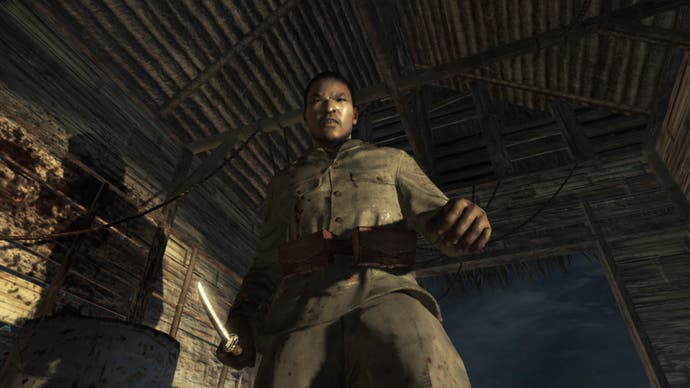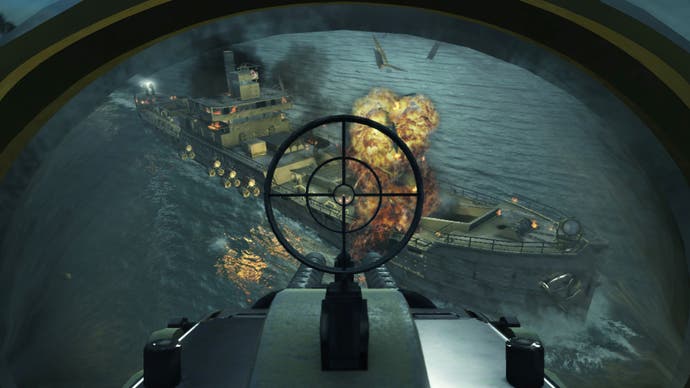Call of Duty: World at War
Still soldiering on.
So it's come to this. Right at the very start of World at War, you're a helpless prisoner of the Japanese, saved from execution at the last second by a rescue squad of US Marines. Handed a rifle, you begin to exact your payback. As you move from hut to hut, one of the game's many scripted moments occurs. Directly in front of you, a Japanese soldier, his uniform ablaze, bursts out at a fellow US soldier. Should you manage to shoot the assailant quickly enough, and thus prevent your team mate from burning alive, you're awarded your first Achievement or Trophy - Saved Private Ryan.
It's an obvious gag, and a revealing one. World at War, it seems, is not a game concerned with avoiding the obvious. Quite the opposite in fact. For a game that goes out of its way to rub your nose in the grisly underbelly of war (opening, rather tastelessly, with what looks like real archive footage of Japanese military executions) it nevertheless nestles snugly inside the predictable comfort zone already established by over a decade of similar WW2 shooters.
That's not to say that World at War doesn't impress. Much like its predecessor, Modern Warfare, this is an exhilarating and painstakingly designed journey through the smoke, flames and dust of armed combat. It's linear and scripted, as all shooters must be to some extent, but the series has always succeeded by hiding the strings better than most. That success wavers here, but there's still plenty to enjoy for those who enjoy shock and awe more than surprises.
The dual storylines follow Private Miller, an American soldier in the Pacific and the subject of the opening rescue, and Red Army soldier Private Petrenko, pulled from the rubble of Stalingrad by the grizzled Sergeant Reznov, brilliantly voiced by Gary Oldman. It's the Russian story that is most interesting, tracking the Soviets as they push the Germans out of the motherland all the way back to Berlin for the climactic assault on the Reichstag. The American story, on the other hand, feels a bit piecemeal and offers a less than satisfying conclusion.
There are thirteen levels in all, although thirteen set pieces may be a more accurate description. If the early Call of Duty games were aping Spielberg, this is videogaming in the Michael Bay style. Each level seems designed to drop you into an instantly thrilling combat scenario, delivered with maximum speaker-rattling intensity and all the particle effects the game engine can muster. When it works, it's as ferociously thrilling as ever. One level, seemingly unrelated to either story, finds you scampering up and down a US seaplane, manning the various turrets to fend off Japanese gunboats and fighters. At one point, you land on the water and must pull the survivors of a Navy convoy to safety while explosions rattle the fuselage.

But when it doesn't work, the game can feel disjointed and disconnected. Levels are connected by swooshing animated segues, which are presumably inspired by the opening credits to the George Clooney thriller, Syriana, but it doesn't do enough to explain who your characters are, or why they're hopping from one location to another. That the levels rigidly herd you in the right direction, only triggering the next sequence once you've passed some invisible trigger, only heightens the artificiality of the scenarios.
Call of Duty has never been about freedom, though. It's a theme park ride, and if you keep your eyes in the direction the game is herding you then you'll get the full effect. Try and deviate from the prescribed path and the illusion is broken, with AI team mates who only advance once you've killed an unexplained number of specific enemies, respawning soldiers that only stop appearing when you trigger the next section by moving in the right direction and lots of other tricks of the trade.
Call of Duty isn't alone in disguising its corridor construction with this sort of thing, of course, and there's a lot of skill in the way the game directs your gaze and engineers staged pseudo-spontaneous moments, but it does seem more reliant on these methods than other shooters. We've seen and beaten these tricks too many times before, and while it's easy to be entertained by the dramatic flourishes we're no longer fooled by the construction, especially when playing through the same section for the fifth time thanks to crude sudden death moments and checkpoints just harsh enough to frustrate.

Grenades are a recurring problem, often landing close enough to kill but too far away to be reached and tossed back safely. That your character has a habit of snagging on small objects as you try to backpedal away from the blast zone simply makes these moments even more annoying. The game also brings back the timed reaction tests from Call of Duty 3, with Japanese troopers screaming "Banzai!" and trying to stick their bayonet in your warm fleshy bits. As the levels get wider, and the battles larger, it's easy to be caught from behind by these guys, at which point you have a split second to bash the button to counter their otherwise instantly deadly attack. The timing is fiddly, and the whole concept still feels cheap, especially since your team mates rarely do anything to help.








